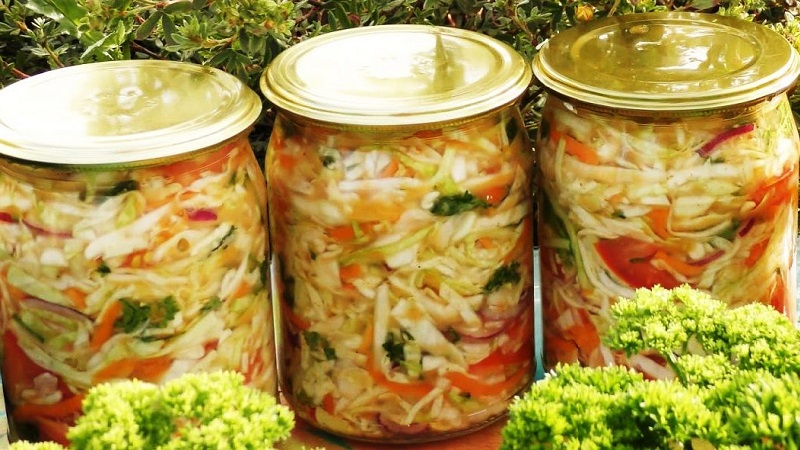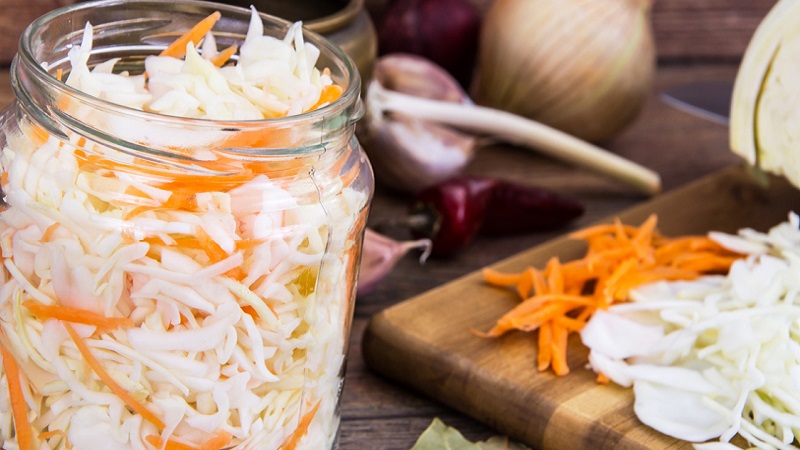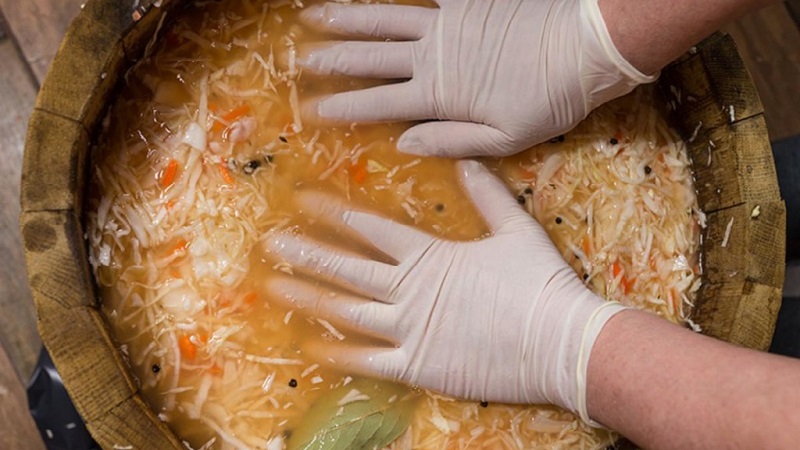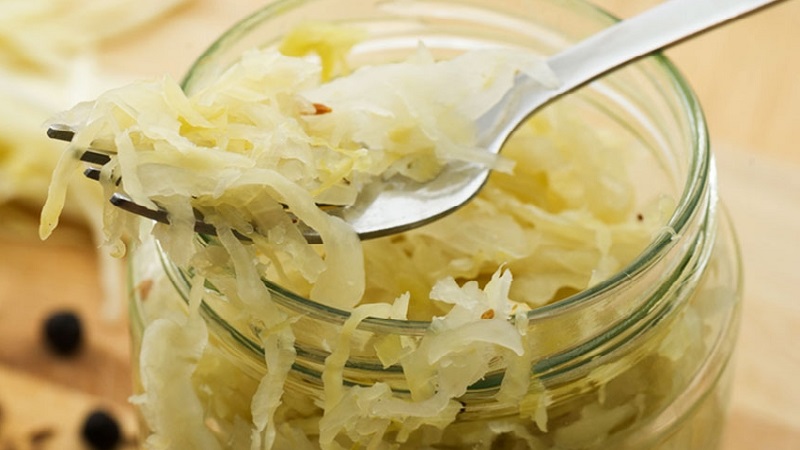Why can you get poisoned with sauerkraut and what to do if this happens
Sauerkraut is one of the most useful winter preparations. All substances are preserved in it, and the amount of vitamin C and some other elements even increases after fermentation. Doctors recommend including this product in your winter diet.
During pickling, cabbage goes through fermentation processes. It acquires special properties and taste thanks to beneficial bacteria. However, if the storage rules or cooking technology are violated, pathological microorganisms begin to multiply in the snack. Then the product becomes dangerous. Is it possible to get poisoned with sauerkraut and how to recognize symptoms in a timely manner, read the article.
The content of the article
Is it possible to get poisoned with sauerkraut

Poisoning is possible with eating sauerkraut, not subjected to additional heat treatment... Also, often the source of harmful bacteria is not the pickle itself, but the additives present in it, and the products with which it was consumed.
In spoiled sauerkraut, various harmful bacteria develop that can cause intoxication. The most dangerous are the causative agents of botulism, which develop not only in meat and fish, but also in any anaerobic environment.
Infection with botulism is possible if the pickles were kept in an airless environment. Such conditions are created in hermetically sealed cans and bags. The spores of the pathogen get into the snack itself along with particles of earth, from dirty hands or with the wrong neighborhood.
Note! In 2010, a case was recorded when a family of 5 fell ill with botulism after eating sauerkraut.
Botulism in cabbage is rare. More often, a spoiled product becomes a medium for the development of E. coli. It causes toxic symptoms, but is not considered fatal.
The greatest risks of infection are when buying cabbage in the market or in a store. Unscrupulous sellers often do not follow the cooking technology, trying to sell the unfermented product as soon as possible.
Pickles with an expired shelf life are also on sale. To hide the signs of a spoiled product, the snack is washed, treated with vinegar and a weak chlorine solution. To mask an unpleasant color and odor, vegetables, berries, fruits, sauces are added to sauerkraut.
The safest to buy sauerkraut without additives, since in this form it is easier to check its suitability for use.
Possible causes of poisoning
Sauerkraut is rarely the cause of poisoning.
This is possible in the following cases:
- Violation of the cooking technology. It is not only the cooking process that matters, but also the products that are used. Compliance with sanitary standards is important.
- Dishes. Sauerkraut produces lactic acid, which interacts with certain materials to release harmful compounds.
- Violation of storage conditions. The product loses its beneficial properties, bacteria multiply in it. The smell, taste and color change.
- Toxic products. The problem arises if the cabbage is grown using chemicals to fight diseases and pests or as fertilizers. Heads of cabbage accumulate toxins, which, entering the human body, cause poisoning.
Storage conditions

Even properly cooked sauerkraut will lead to poisoning if stored improperly.
In order for the product to remain useful for a long time and pathogenic bacteria do not develop in it, the following storage conditions are observed:
- Temperature... The optimal performance for sauerkraut is -2 ... + 4 ° C (it will not deteriorate for 8 months), but it can be stored without consequences at temperatures up to + 8 ° C (up to a month). Higher rates create an optimal environment for the development of pathogenic bacteria. In winter, pickles are stored on the balcony. If they freeze, this will not negatively affect their taste or useful properties. Also, cabbage is stored in the refrigerator.
- Tightness... The container with the cabbage must be closed. This will protect the workpiece from the ingress of pathogenic bacteria and fungi from the outside, protect it from contact with air, and increase the shelf life.
- Humidity... This figure should average 80%. Low humidity leads to rapid evaporation of the brine. If the snack is not completely covered with liquid, it will darken on contact with air and its taste will change.
- Storage periods... Sauerkraut is stored for up to 8 months in wooden barrels, enameled dishes, in which it was fermented after cooking. From 4 to 6 months the product will remain usable in hermetically sealed glass jars. In open containers in the refrigerator, pickles will not deteriorate for 4-7 days. In all cases, the cabbage should be covered with brine.
After the expiration date, eating pickles is dangerous to health. To preserve sauerkraut for more than six months, it is frozen.
Incorrect preparation

It is important to ferment cabbage correctly. If the technology is not followed, the product will not benefit the body, but harm.
Rules for pickling cabbage:
- Head processing... Most of the chemicals are collected in the stalk and on the top leaves of cabbage. These parts must be removed. The remaining leaves are soaked for 15 minutes in a salt solution. These actions will help get rid of more than 75% of harmful substances. The rest of the body will remove without damage.
- Purity... It is important to wash your hands thoroughly before cooking. Dishes and knives are treated with a special agent, it is better to wear gloves on your hands. It is not recommended to use boards for cutting heads of cabbage, on which raw meat and fish products were cut.
- The choice of the variety. Late varieties are suitable for fermentation. Early and middle leaves have less dense leaves, and during fermentation they quickly lose their structure and color. In such a product, bacteria multiply faster.
- Correct ratio of salt and vegetables... The amount of salt should be 2% of the total weight of the food.
- Compliance with the terms of fermentation. You can eat sauerkraut no earlier than 2 weeks after the start of cooking. It is especially dangerous to use it in the first 2 days, since during this period the fermentation process is not yet complete.
- Actions during cooking. The resulting foam is removed from the cabbage and the salad is pierced with a skewer, releasing gas.
Sauerkraut consists of 4 stages:
- Juicing. The products that make up the snack let the juice go. It begins to ferment, but due to the high salt concentration, lactic bacteria do not develop. Gradually, the amount of juice increases, the brine becomes less concentrated.
- Formation of lactic acid bacteria... When there is a lot of juice, it begins to ferment. The process is accompanied by the release of carbon dioxide, clouding of the brine, and the formation of foam. Reproduction of lactic acid bacteria leads to such effects. This and the previous stages should take place at a temperature of + 17 ... + 22 ° C.
- Accumulation of lactic acid. It occurs due to the decomposition processes taking place in the product. The duration of the process is 5-7 days. All this time, the temperature is maintained at + 20 ° C. The formation of lactic acid is suspended when its concentration is 1.5-2%.
- Fermentation. Lactic acid inhibits lactic acid bacteria. During this period, there is a risk of mold formation. To prevent this, the container with cabbage is moved to a room with a temperature not higher than + 8 ° C.

Unsuitable cookware
Plastic and metal are not suitable for pickling cabbage, because when interacting with lactic acid, they release compounds harmful to the human body. This can cause poisoning.
It is best to ferment vegetables in a wooden or glass container. Enamelled containers are also suitable, but in this case it is important to make sure that there are no chips.
Signs of spoiled and good cabbage

To avoid poisoning, it is important to be able to distinguish between edible and rotten sauerkraut.
The main parameters to pay attention to:
- Colour... The salad should be light, with a uniform color. If the composition contains carrots, the presence of a yellowish tint is permissible. The absence of gray, green, pink, reddish and other uncharacteristic colors is important. They indicate the presence of mold or mildew. A greyish tint can also be a sign that the heads of cabbage were not washed well before cooking. A snow-white shade indicates non-compliance with the cooking technology.
- Composition... Only salt, cabbage, sometimes carrots should be present. A small amount of berries and fruits is acceptable, but buying such salads is more dangerous than ordinary sauerkraut. The composition should not contain vinegar, sugar and other preservatives.
- Smell... A quality product has a specific aroma with a slight acidity. If the smell is musty, you cannot eat such cabbage.
- Texture... Vegetables should be firm, firm, and crispy. Better if they are thinly sliced. If the cabbage is soft and sluggish, it means that the storage or preparation rules have been violated.
- Taste... High-quality cabbage should be slightly sour, with a slight edge. Too sour, sweet taste, as well as off-flavors indicate that the product is spoiled.
- Brine... The pickle should be completely covered with it.
- Foreign inclusions... Slime, mold, and a film on the brine are the main signs of spoiled cabbage. It cannot be eaten even in processed form.
If only the top layer of the salad is affected, it will still not be possible to save it by getting rid of the spoiled part. Mold, bacteria and their toxins, fungi have time to spread throughout the salting.
It is not recommended to eat spoiled cabbage, even if it has been cooked. Despite the fact that during heat treatment above + 100 ° C, harmful microorganisms die, in order to get rid of their toxins, you will need to cook the dish at a temperature of + 120 ° C for at least 10 minutes.
It is interesting:
Is it possible to sauerkraut with breastfeeding
Recipes of lightly salted and sauerkraut instant in 1 day and 2 hours
What to do if you get poisoned with sauerkraut
Poisoning with sauerkraut occurs when harmful microorganisms and their toxins enter the gastrointestinal tract. There they begin to multiply rapidly, suppressing their own microflora and immune cells.
From the gastrointestinal tract, pathogenic microorganisms and their waste products enter the bloodstream, which leads to intoxication. Its severity and consequences depend on the correctness of the treatment. The sooner the problem is identified and eliminated, the more chances for a complete and quick recovery.
Symptoms
To start the treatment of poisoning on time, you need to know its symptoms:
- Nausea and repeated vomiting for 1-5 days. Vomiting occurs after every meal or water intake.
- Diarrhea. In some cases, it is missing.
- Painful sensations in the abdomen. Pain is often localized around the navel.
- Weakness, lethargy, drowsiness.
- Impaired coordination of movements.
- Dizziness.
- Temperature from 37 to 38.5 ° C.
Sometimes poisoning is accompanied by tachycardia, convulsions, cyanosis of the extremities, chills, headache.
Dehydration is always present. If dehydration is severe, loss of consciousness is possible.
Attention! If a person is allergic to mold, poisoning with spoiled sauerkraut may accompany anaphylaxis. One of its signs is the blue discoloration of the nasolabial triangle.
First aid, treatment
If spoiled cabbage was eaten, nausea appeared, but vomiting is not yet, the stomach is washed. To do this, you need to drink about 1.5 liters of water or a light pink solution of potassium permanganate. If in the process of vomiting did not follow, it is caused by pressing fingers on the root of the tongue.
If symptoms of intoxication appear, first aid should be as follows:
- Reception of absorbing drugs: "Atoxil", "Enterosgel", activated carbon, etc. The funds are taken according to the instructions.
- Elimination of dehydration. After each vomiting, you need to drink 1-1.5 liters of water for an adult and 50-200 ml for a child. This should be done in small portions every 5 minutes so as not to induce vomiting. It is better to drink not plain water, but saline solutions, for example, "Regidron".
- If diarrhea is absent and vomiting is severe, a laxative such as magnesium sulfate should be used.
- If there is a temperature above 38 ° C, an antipyretic agent ("Nurofen") is taken.
- In case of severe pain, they take antispasmodics, for example, "No-Shpu".
If the poisoning is severe, the doctor will prescribe a course of antibiotics lasting from 3 days to 2 months. It is forbidden to take medications on your own.
Further recovery
In the acute phase of poisoning (in the presence of severe symptoms), it is recommended to refuse food intake. At this time, they drink herbal teas, still water, dried fruit compote.
It is allowed to take food the next day after the acute phase is eliminated. The recovery period lasts at least a week. At this time, food should be sparing. Food should not be fatty, fried, smoked, salty, spicy. It is forbidden to eat snacks, carbonated drinks, fast food, sweets, yeast, puff, pastry dough.
The patient should eat boiled or stewed food with a minimum amount of oil. Sour-milk fat-free products, lean meat of adult animals, cereals without oil, vegetables and fruits with low acidity are allowed.
In what cases is medical assistance needed
In some cases, self-treatment is impossible. A doctor is called if:
- a child, an elderly person, a woman during pregnancy, a person with chronic diseases of the liver, pancreas, gastrointestinal tract was injured;
- first aid did not bring positive results or the condition worsened;
- blood traces were found in vomit or feces;
- an increase in temperature is accompanied by convulsions;
- severe dehydration, impaired consciousness, or fainting occurs.
The doctor will adjust the treatment or refer the patient to the infectious diseases department. There they will take smears, prescribe a course of antibiotics, put on a dropper to eliminate dehydration, etc.
Note! Usually, after the treatment of poisoning, enzyme preparations and hepatoprotectors are prescribed to normalize liver function.
Possible consequences
The intoxication of the body does not always pass without consequences.
With improper and untimely treatment, the following pathologies may occur:
- inflammation of the liver, pancreas, bile ducts;
- hepatic and renal failure;
- bowel irritation;
- dehydration.
In rare cases, death or coma is possible.
Conclusion
Poisoning with sauerkraut is a rare but dangerous occurrence. It occurs if the product was prepared in violation of technology or stored incorrectly. The symptoms of poisoning are the same as for any other intoxication of the body. In case of untimely treatment, the development of consequences dangerous to life and health is possible.
To cure the poisoning and avoid unpleasant consequences, it is important to provide the patient with first aid correctly and in a timely manner. It is better not to self-medicate, but to contact your doctor or call an ambulance.